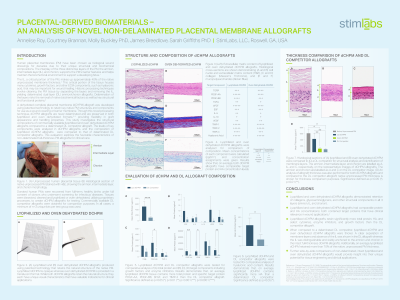Laboratory Research
(LR-043) Placental-Derived Biomaterials – An Analysis of Novel Non-Delaminated Placental Membrane Allografts
Friday, April 28, 2023
7:15 PM - 8:30 PM East Coast USA Time

Courtney Brannan, n/a – Scientist, StimLabs; Molly Buckley, PhD – Scientist, StimLabs; Jimmy Breedlove, n/a – R&D Technician, StimLabs; Sarah Griffiths, PhD – CSO, StimLabs
Introduction: Human placental membranes (PM) have shown success as biological dressings due to their unique structural and biochemical compositions1-3. The interplay of the PM layers, the amnion, intermediate layer (IL), and chorion, supports PM’s barrier features and helps maintain the biochemical environment to support a developing fetus3.
Historic preservation techniques involve cleaning the tissue by separating the layers and removing the IL, yielding delaminated dual layer (DL) amnion/chorion allografts3. Delaminating risks removal of native biochemical factors as well as key structural and functional proteins3. A proprietary process was developed that preserves the PM tissue without delamination, with two possible dehydration methods yielding either a lyophilized or a translucent dehydrated complete human placental membrane (dCHPM) allograft. Herein, we analyzed the two dCHPMs, which retain the native structure and biochemical environment of the native PM; additionally, the lyophilized dCHPM was compared to a DL allograft.
Methods: A histological analysis, thickness measurements, and ELISAs were conducted on select ECM components in dCHPM allografts and a DL allograft. Further, we analyzed and compared the proteomic profiles of lyophilized dCHPM and translucent dCHPM allografts.
Results: dCHPM allografts demonstrate retention of collagens, glycosaminoglycans, proteoglycans, and other structural components in the amnion, chorion, and IL. The IL is distinguishable and visibly anchored to the amnion and chorion, creating an intact full-thickness allograft. A clear separation of membrane layers and absence of the IL was shown in the DL allograft. The lyophilized dCHPM was 4.41 times thicker than the DL allograft. Of the select components measured via ELISA, lyophilized dCHPM has 4.30, 5.05, 6.55, and 3.15 times more protein, cytokines and enzyme inhibitors, and hyaluronic acid (HA), respectively, than the DL allograft. Translucent and lyophilized dCHPM have comparable proteomic profiles.
Discussion: Maintaining the native PM structure in the dCHPM allografts was critical to retaining substantial tissue thickness and notably more protein and HA than the DL allograft. Further, the two preservation methods for yielding dCHPM allografts provide flexibility in graft appearance and handling characteristics without compromising composition or integrity, shown by the histological and proteomic results. Therefore, the favorable characteristics of a non-delaminated full-thickness PM allograft have valuable implications in wound care.
Historic preservation techniques involve cleaning the tissue by separating the layers and removing the IL, yielding delaminated dual layer (DL) amnion/chorion allografts3. Delaminating risks removal of native biochemical factors as well as key structural and functional proteins3. A proprietary process was developed that preserves the PM tissue without delamination, with two possible dehydration methods yielding either a lyophilized or a translucent dehydrated complete human placental membrane (dCHPM) allograft. Herein, we analyzed the two dCHPMs, which retain the native structure and biochemical environment of the native PM; additionally, the lyophilized dCHPM was compared to a DL allograft.
Methods: A histological analysis, thickness measurements, and ELISAs were conducted on select ECM components in dCHPM allografts and a DL allograft. Further, we analyzed and compared the proteomic profiles of lyophilized dCHPM and translucent dCHPM allografts.
Results: dCHPM allografts demonstrate retention of collagens, glycosaminoglycans, proteoglycans, and other structural components in the amnion, chorion, and IL. The IL is distinguishable and visibly anchored to the amnion and chorion, creating an intact full-thickness allograft. A clear separation of membrane layers and absence of the IL was shown in the DL allograft. The lyophilized dCHPM was 4.41 times thicker than the DL allograft. Of the select components measured via ELISA, lyophilized dCHPM has 4.30, 5.05, 6.55, and 3.15 times more protein, cytokines and enzyme inhibitors, and hyaluronic acid (HA), respectively, than the DL allograft. Translucent and lyophilized dCHPM have comparable proteomic profiles.
Discussion: Maintaining the native PM structure in the dCHPM allografts was critical to retaining substantial tissue thickness and notably more protein and HA than the DL allograft. Further, the two preservation methods for yielding dCHPM allografts provide flexibility in graft appearance and handling characteristics without compromising composition or integrity, shown by the histological and proteomic results. Therefore, the favorable characteristics of a non-delaminated full-thickness PM allograft have valuable implications in wound care.

.png)